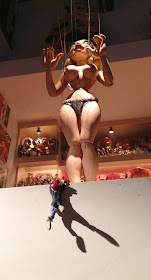American illustrator Al Dorne (1906-1965) painted this ad showing mother who is exhausted from hosting a birthday party being perked up by the thought of some Maxwell House coffee.
Dorne created the illustration with layers of transparent inks. In American Artist magazine, the Higgins ink company ran another ad sharing Dorne's method: "In working with waterproof drawing inks, Mr. Dorne finds that the tones never become muddy, no matter how many washes are used."
Here's an enlarged section of the preliminary pencil drawing. Dorne was a master of drawing hands. Note how authoritatively he drew the bones and tendons of the relaxed hand. Even though the hand is in shadow in the final painting, the light seems directional enough to bring out the anatomy.
The caption from the Higgins ad says: "The First Consideration. Because of the transparency of colored inks when used as a "painting" medium—a meticulous and thoroughly organized pencil drawing is important."
True, but it begs the question: How was Dorne able to change her from a brunette to a blonde and turn her head slightly in the published illustration (see first image in the post). Did he cover the original rendering with a layer of opaque priming? Or did he mortise in the correction with another piece of board? I'll bet it's the latter, and that he covered the mortise line with the addition of a choker.
In the days before Photoshop, such changes were a pain in the royal butt.
In any event, the notes say: "A rather finished underpainting in black and white establishes values and forms, important when colored inks are used as glazes in painting. Finally, colored inks are glazed over the monochrome drawing. A fully modeled painting results."
----
Wikipedia on Al Dorne
Book: Albert Dorne: Master Illustrator
Higgins still makes black waterproof ink or you can get a set of colors










































